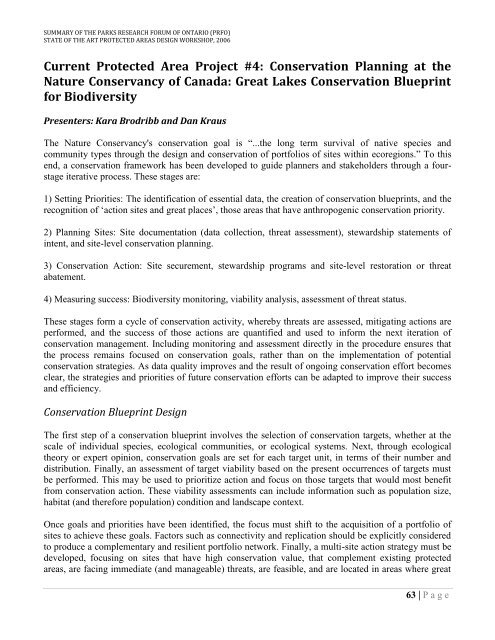Top-Down vs. Bottom Up: Working Towards Consensus ... - CASIOPA
Top-Down vs. Bottom Up: Working Towards Consensus ... - CASIOPA
Top-Down vs. Bottom Up: Working Towards Consensus ... - CASIOPA
- No tags were found...
You also want an ePaper? Increase the reach of your titles
YUMPU automatically turns print PDFs into web optimized ePapers that Google loves.
SUMMARY OF THE PARKS RESEARCH FORUM OF ONTARIO (PRFO)STATE OF THE ART PROTECTED AREAS DESIGN WORKSHOP, 2006Current Protected Area Project #4: Conservation Planning at theNature Conservancy of Canada: Great Lakes Conservation Blueprintfor BiodiversityPresenters: Kara Brodribb and Dan KrausThe Nature Conservancy's conservation goal is “...the long term survival of native species andcommunity types through the design and conservation of portfolios of sites within ecoregions.” To thisend, a conservation framework has been developed to guide planners and stakeholders through a fourstageiterative process. These stages are:1) Setting Priorities: The identification of essential data, the creation of conservation blueprints, and therecognition of „action sites and great places‟, those areas that have anthropogenic conservation priority.2) Planning Sites: Site documentation (data collection, threat assessment), stewardship statements ofintent, and site-level conservation planning.3) Conservation Action: Site securement, stewardship programs and site-level restoration or threatabatement.4) Measuring success: Biodiversity monitoring, viability analysis, assessment of threat status.These stages form a cycle of conservation activity, whereby threats are assessed, mitigating actions areperformed, and the success of those actions are quantified and used to inform the next iteration ofconservation management. Including monitoring and assessment directly in the procedure ensures thatthe process remains focused on conservation goals, rather than on the implementation of potentialconservation strategies. As data quality improves and the result of ongoing conservation effort becomesclear, the strategies and priorities of future conservation efforts can be adapted to improve their successand efficiency.Conservation Blueprint DesignThe first step of a conservation blueprint involves the selection of conservation targets, whether at thescale of individual species, ecological communities, or ecological systems. Next, through ecologicaltheory or expert opinion, conservation goals are set for each target unit, in terms of their number anddistribution. Finally, an assessment of target viability based on the present occurrences of targets mustbe performed. This may be used to prioritize action and focus on those targets that would most benefitfrom conservation action. These viability assessments can include information such as population size,habitat (and therefore population) condition and landscape context.Once goals and priorities have been identified, the focus must shift to the acquisition of a portfolio ofsites to achieve these goals. Factors such as connectivity and replication should be explicitly consideredto produce a complementary and resilient portfolio network. Finally, a multi-site action strategy must bedeveloped, focusing on sites that have high conservation value, that complement existing protectedareas, are facing immediate (and manageable) threats, are feasible, and are located in areas where great63 | P a g e


